A Novel Steady-State Simulation Approach for a Combined Electric and Steam System Considering Steam Condensate Loss
Abstract
:1. Introduction
2. Simulation Model of CESS
2.1. Simulation Model of the Power Subsystem
2.2. Simulation Model of the Steam Heating Subsystem
2.2.1. Model Assumptions
2.2.2. Pipeline Momentum Conservation Equations
2.2.3. Nodal Mass Flow Conservation Equations
2.2.4. Pipeline Mass Flow Conservation Equations
2.2.5. Pipeline Energy Conservation Equations
2.2.6. Summary of the Control Equations for the Steam Heating Network
2.3. Simulation Models of Thermoelectric Coupling Equipment
2.3.1. Simulation Model of CHP Units
- Back-pressure unit
- 2.
- Extraction condensing unit
2.3.2. Simulation Model of the Electric Boiler
3. Simulation Computation of CESS
3.1. Computation of the Steam Heating Subsystem
3.1.1. Solution Conditions
3.1.2. Establishment of the Equations and Solution
3.2. Computation of CESS
3.2.1. Back-Pressure Units Only
3.2.2. Containing Extraction Condensing Units
4. Case Verification and Analysis
4.1. Case Verification of the Steam Heating Subsystem
4.1.1. Nine-Node Double-Heat-Source Tree Network
4.1.2. Performance Comparison of Steam Heating Network Models
4.1.3. Nine-Node Double-Heat-Source Ring Network
4.2. Case Analysis of CESS
4.2.1. Network Structure and Parameters
4.2.2. Simulation Computation
4.2.3. Impacts of Electric Boilers on Renewable Energy Consumption
5. Conclusions
Author Contributions
Funding
Institutional Review Board Statement
Informed Consent Statement
Data Availability Statement
Conflicts of Interest
Appendix A
| Pipeline Label | Pipeline Number | Length (m) | Diameter (m) | Heat Transfer Coefficient |
|---|---|---|---|---|
| G113 | 1 | 540.6 | 0.8 | 0.531 |
| Z111 | 2 | 162.64 | 0.8 | 0.395 |
| G001 | 3 | 953.89 | 0.8 | 0.531 |
| G114 | 4 | 609.97 | 0.8 | 0.75 |
| Z112 | 5 | 489.17 | 0.8 | 0.566 |
| G002 | 6 | 1486.86 | 0.8 | 0.75 |
| G003 | 7 | 728.03 | 0.8 | 0.742 |
| J075 | 8 | 25.4 | 0.8 | 0.887 |
| Pipeline Number | Length (m) | Diameter (m) | Heat Transfer Coefficient |
|---|---|---|---|
| 1 | 600 | 0.8 | 0.6 |
| 2 | 600 | 0.6 | 0.6 |
| 3 | 1000 | 0.4 | 0.6 |
| 4 | 600 | 0.7 | 0.6 |
| 5 | 1000 | 0.6 | 0.6 |
| 6 | 1000 | 0.8 | 0.6 |
| 7 | 500 | 0.6 | 0.6 |
| 8 | 500 | 0.6 | 0.6 |
| 9 | 800 | 0.6 | 0.6 |
| Pipeline Number | Length (m) | Diameter (m) | Heat Transfer Coefficient |
|---|---|---|---|
| 1 | 522 | 1 | 0.75 |
| 2 | 313 | 0.6 | 0.668 |
| 3 | 476 | 0.6 | 0.668 |
| 4 | 968 | 0.6 | 0.668 |
| 5 | 397 | 0.5 | 0.668 |
| 6 | 368 | 0.5 | 0.668 |
| 7 | 376 | 0.5 | 0.668 |
| 8 | 294 | 0.5 | 0.668 |
| 9 | 312 | 0.5 | 0.668 |
| 10 | 1256 | 0.6 | 0.668 |
| 11 | 244 | 0.5 | 0.668 |
| 12 | 350 | 0.4 | 0.668 |
References
- Orecchini, F.; Santiangeli, A. Beyond Smart Grids—The Need of Intelligent Energy Networks for a Higher Global Efficiency through Energy Vectors Integration. Int. J. Hydrogen Energy 2011, 36, 8126–8133. [Google Scholar] [CrossRef]
- Li, J.; Ying, Y.; Lou, X.; Fan, J.; Chen, Y.; Bi, D. Integrated Energy System Optimization Based on Standardized Matrix Modeling Method. Appl. Sci. 2018, 8, 2372. [Google Scholar] [CrossRef] [Green Version]
- Zhou, S.; Sun, K.; Wu, Z.; Gu, W.; Wu, G.; Li, Z.; Li, J. Optimized Operation Method of Small and Medium-Sized Integrated Energy System for P2G Equipment under Strong Uncertainty. Energy 2020, 199, 117269. [Google Scholar] [CrossRef]
- Wu, C.; Gu, W.; Xu, Y.; Jiang, P.; Lu, S.; Zhao, B. Bi-Level Optimization Model for Integrated Energy System Considering the Thermal Comfort of Heat Customers. Appl. Energy 2018, 232, 607–616. [Google Scholar] [CrossRef]
- Buffa, S.; Cozzini, M.; D’Antoni, M.; Baratieri, M.; Fedrizzi, R. 5th Generation District Heating and Cooling Systems: A Review of Existing Cases in Europe. Renew. Sust. Energ. Rev. 2019, 104, 504–522. [Google Scholar] [CrossRef]
- Qi, H.; Yue, H.; Zhang, J.; Lo, K.L. Optimisation of a Smart Energy Hub with Integration of Combined Heat and Power, Demand Side Response and Energy Storage. Energy 2021, 234, 121268. [Google Scholar] [CrossRef]
- Nesheim, S.J.; Ertesvag, I.S. Efficiencies and Indicators Defined to Promote Combined Heat and Power. Energy Conv. Manag. 2007, 48, 1004–1015. [Google Scholar] [CrossRef]
- Cardona, E.; Piacentino, A. Cogeneration: A Regulatory Framework toward Growth. Energy Policy 2005, 33, 2100–2111. [Google Scholar] [CrossRef]
- Zhao, L. Analysis of the Status Quo, Problems and Suggestions of the Development of Combined Heat and Power Central Heating in China Based on Big Data Technology. J. Phys. Conf. Ser. 2020, 1648, 022150. [Google Scholar] [CrossRef]
- Zhao, X.; Wei, C.; Xin, G. Present situation of heat supply in Zhejiang and study on steam heat supply distance. Energy Res. Info. 2008, 24, 132–133. [Google Scholar]
- Xianxi, L.; Shubo, L.; Menghua, X.; Ying, H. Modeling and Simulation of Steam Pipeline Network with Multiple Supply Sources in Iron& Steel Plants. In Proceedings of the 28th Chinese Control and Decision Conference (2016 Ccdc), New York, NY, USA, 28–30 May 2016; pp. 4667–4671. [Google Scholar] [CrossRef]
- Garcia-Gutierrez, A.; Martinez-Estrella, J.I.; Hernandez-Ochoa, A.F.; Verma, M.P.; Mendoza-Covarrubias, A.; Ruiz-Lemus, A. Development of a Numerical Hydraulic Model of the Los Azufres Steam Pipeline Network. Geothermics 2009, 38, 313–325. [Google Scholar] [CrossRef]
- Gao, J.; Cao, H.; Wei, R.; Chen, Z.; Huang, Z. Simulation study on condensation quantity of steam supply pipe network and its influence factors. Therm. Power Gener. 2021, 50, 70–76. [Google Scholar] [CrossRef]
- Wang, H.; Wang, H.; Zhu, T.; Deng, W. A Novel Model for Steam Transportation Considering Drainage Loss in Pipeline Networks. Appl. Energy 2017, 188, 178–189. [Google Scholar] [CrossRef]
- Zhang, H. Simulation of Steam Pipeline Network for Tianjin Airport Industry Park. Master’s Thesis, Tianjin University, Tianjin, China, 2010. [Google Scholar]
- Wang, L.; Yu, S.; Kong, F.; Sun, X.; Zhou, Y.; Zhong, W.; Lin, X. A Study on Energy Storage Characteristics of Industrial Steam Heating System Based on Dynamic Modeling. Energy Rep. 2020, 6, 190–198. [Google Scholar] [CrossRef]
- Song, Y.; Cheng, F.; Cai, R.; Yang, X.; Yang, X.Y. Steam heating network simulation. J. Tsinghua Univ. (Sci. Tech.) 2001, 41, 101–104. [Google Scholar] [CrossRef]
- Liu, X.; Wu, J.; Jenkins, N.; Bagdanavicius, A. Combined Analysis of Electricity and Heat Networks. Appl. Energy 2016, 162, 1238–1250. [Google Scholar] [CrossRef] [Green Version]
- Awad, B.; Chaudry, M.; Wu, J.; Jenkins, N. Integrated Optimal Power Flow for Electric Power and Heat in a Microgrid. In Proceedings of the 20th International Conference and Exhibition on Electricity Distribution (CIRED 2009), Prague, Czech, 8–11 June 2009; p. 4. [Google Scholar]
- Rees, M.; Wu, J.; Awad, B. Steady State Flow Analysis for Integrated Urban Heat and Power Distribution Networks. In Proceedings of the 2009 44th International Universities Power Engineering Conference (UPEC), Glasgow, UK, 1–4 September 2009; pp. 1–5. [Google Scholar]
- Felten, B. An Integrated Model of Coupled Heat and Power Sectors for Large-Scale Energy System Analyses. Appl. Energy 2020, 266, 114521. [Google Scholar] [CrossRef]
- Ma, H.; Chen, Q.; Hu, B.; Sun, Q.; Li, T.; Wang, S. A Compact Model to Coordinate Flexibility and Efficiency for Decomposed Scheduling of Integrated Energy System. Appl. Energy 2021, 285, 116474. [Google Scholar] [CrossRef]
- Zhou, Y.; Guo, S.; Xu, F.; Cui, D.; Ge, W.; Chen, X.; Gu, B. Multi-Time Scale Optimization Scheduling Strategy for Combined Heat and Power System Based on Scenario Method. Energies 2020, 13, 1599. [Google Scholar] [CrossRef] [Green Version]
- Tian, Z.; Niu, J.; Lu, Y.; He, S.; Tian, X. The Improvement of a Simulation Model for a Distributed CCHP System and Its Influence on Optimal Operation Cost and Strategy. Appl. Energy 2016, 165, 430–444. [Google Scholar] [CrossRef]
- Wang, X.; Li, P.; Zhang, J.; Zheng, Y.; Li, H.; Hu, W. Optimal Planning and Operation of Typical Rural Integrated Energy Systems Based on Five-Level Energy Hub. In Proceedings of the 2021 3rd Asia Energy and Electrical Engineering Symposium (aeees 2021), New York, NY, USA, 26–29 March 2021; pp. 1108–1117. [Google Scholar]
- Murty, P.S.R. Chapter 13—Graph Theory and Network Matrices. In Electrical Power Systems; Murty, P.S.R., Ed.; Butterworth-Heinemann: Boston, MA, USA, 2017; pp. 277–300. ISBN 978-0-08-101124-9. [Google Scholar]
- Murty, P.S.R. Chapter 19—Load Flow Analysis. In Electrical Power Systems; Murty, P.S.R., Ed.; Butterworth-Heinemann: Boston, MA, USA, 2017; pp. 527–587. ISBN 978-0-08-101124-9. [Google Scholar]
- Lurie, M.V. Modeling of Oil Product and Gas Pipeline Transportation, 1st ed.; Wiley: Hoboken, NJ, USA, 2008; ISBN 978-3-527-40833-7. [Google Scholar]
- Gao, L. Hydraulic and Thermal Coupling Calculation for Steam Heating Pipe Network. Master’s Thesis, Shandong Jianzhu University, Shandong, China, 2009. [Google Scholar] [CrossRef]
- Sheng, T.; Sun, H.; Wu, C.; Guo, Q.; Wu, Z.; Xiong, W.; Wang, L.; Tang, L. State Estimation for Steam Networks Considering Drainage and Parameter Uncertainties. In Proceedings of the 2017 IEEE Conference on Energy Internet and Energy System Integration (ei2), New York, NY, USA, 26–28 November 2017. [Google Scholar]
- Tang, H.; Fan, J. Urban Heating Manual; TJKJ: Tianjin, China, 1991. [Google Scholar]
- Yu, Y.; Huang, R. Fitting Formula of Specific Volume and Enthalpy of Water and Steam. East China Electr. Power 1999, 27, 19–20. [Google Scholar]
- Feng, F. Application of Heat-Loss Assessment Method Based on Mathematical Model of Steam Pipe Net-Work. Guangdong Chem. Ind. 2014, 41, 35–37. [Google Scholar]
- Zhao, S.; Du, X.; Ge, Z.; Yang, Y. Cascade Utilization of Flue Gas Waste Heat in Combined Heat and Power System with High Back-Pressure (CHP-HBP). In Proceedings of the Clean Energy for Clean City: Cue 2016—Applied Energy Symposium and Forum: Low-Carbon Cities and Urban Energy Systems; Elsevier Science Bv: Amsterdam, The Netherlands, 2016; Volume 104, pp. 27–31. [Google Scholar]
- Huang, L.; Yang, B. Cause analysis and solution of pipe damage of steam heating pipeline. Super Sci. 2016, 32, 247–248. [Google Scholar]
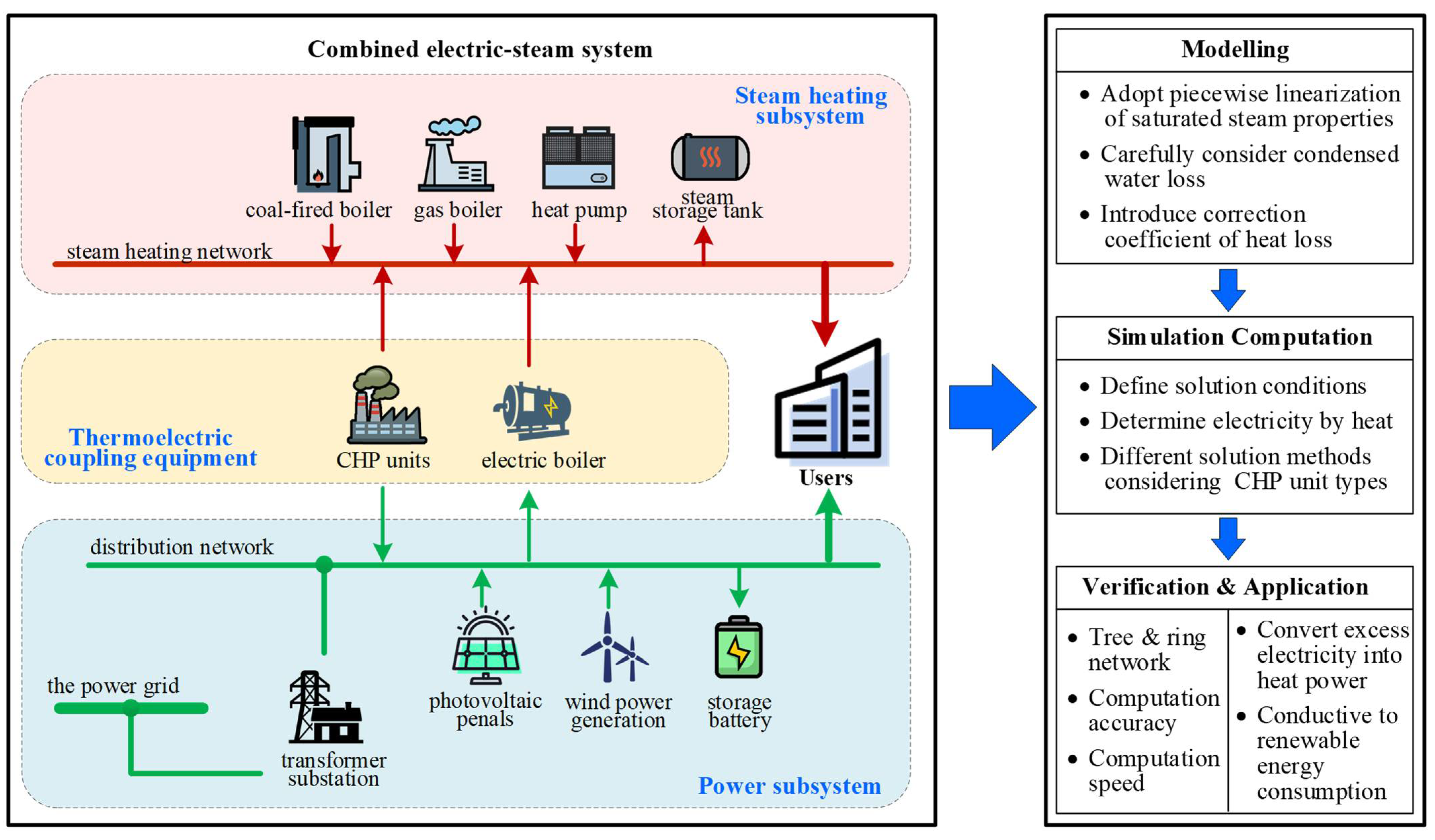


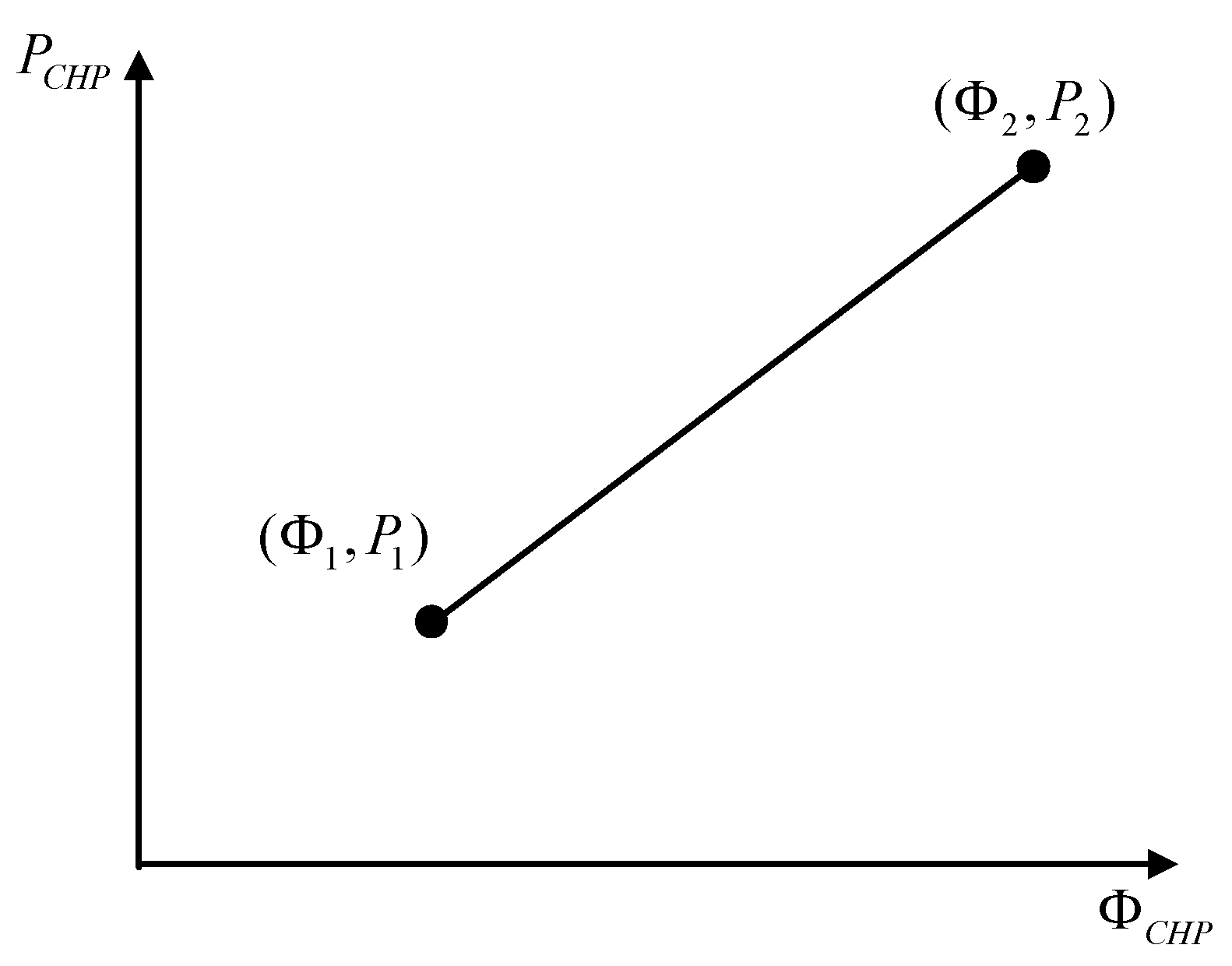

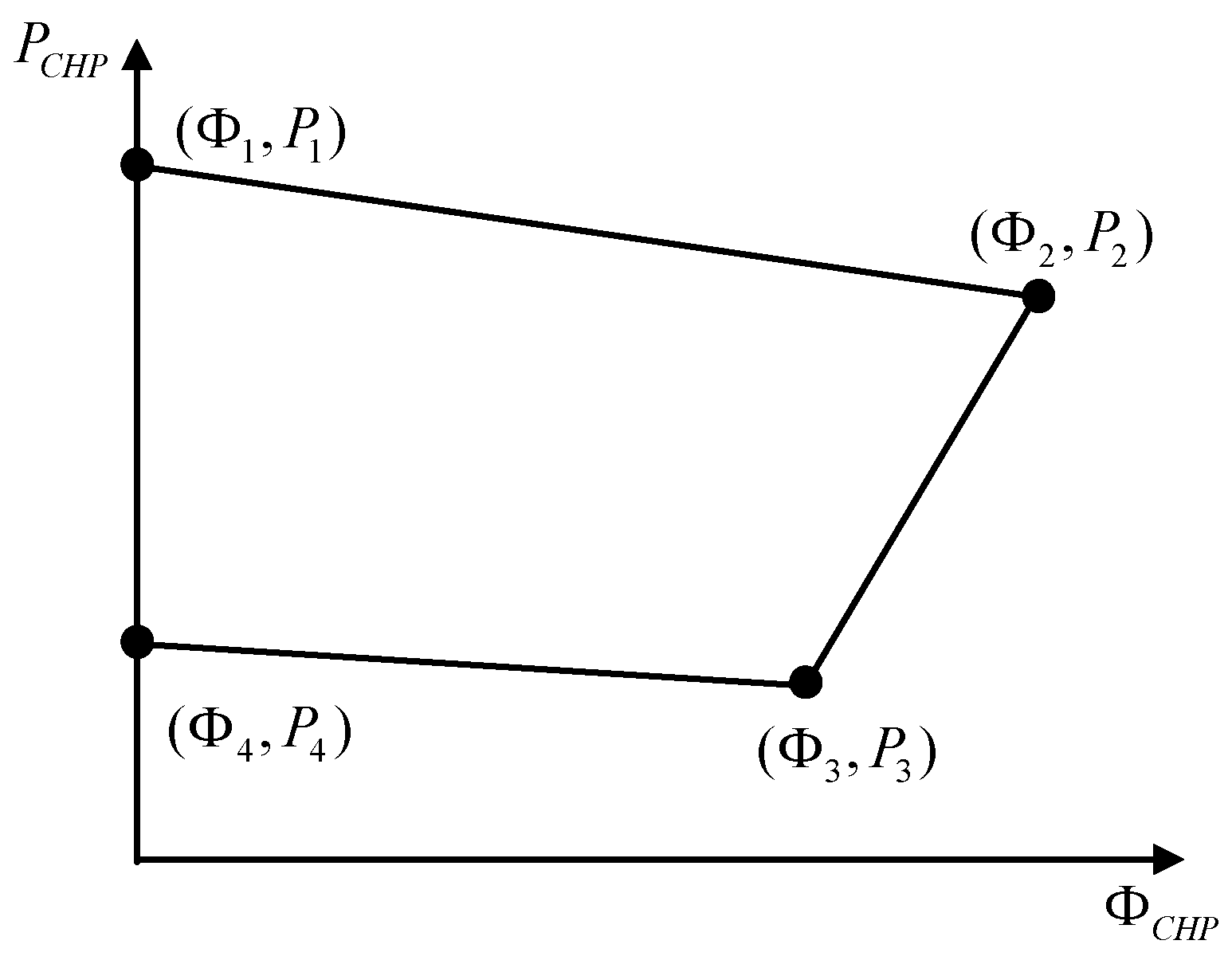
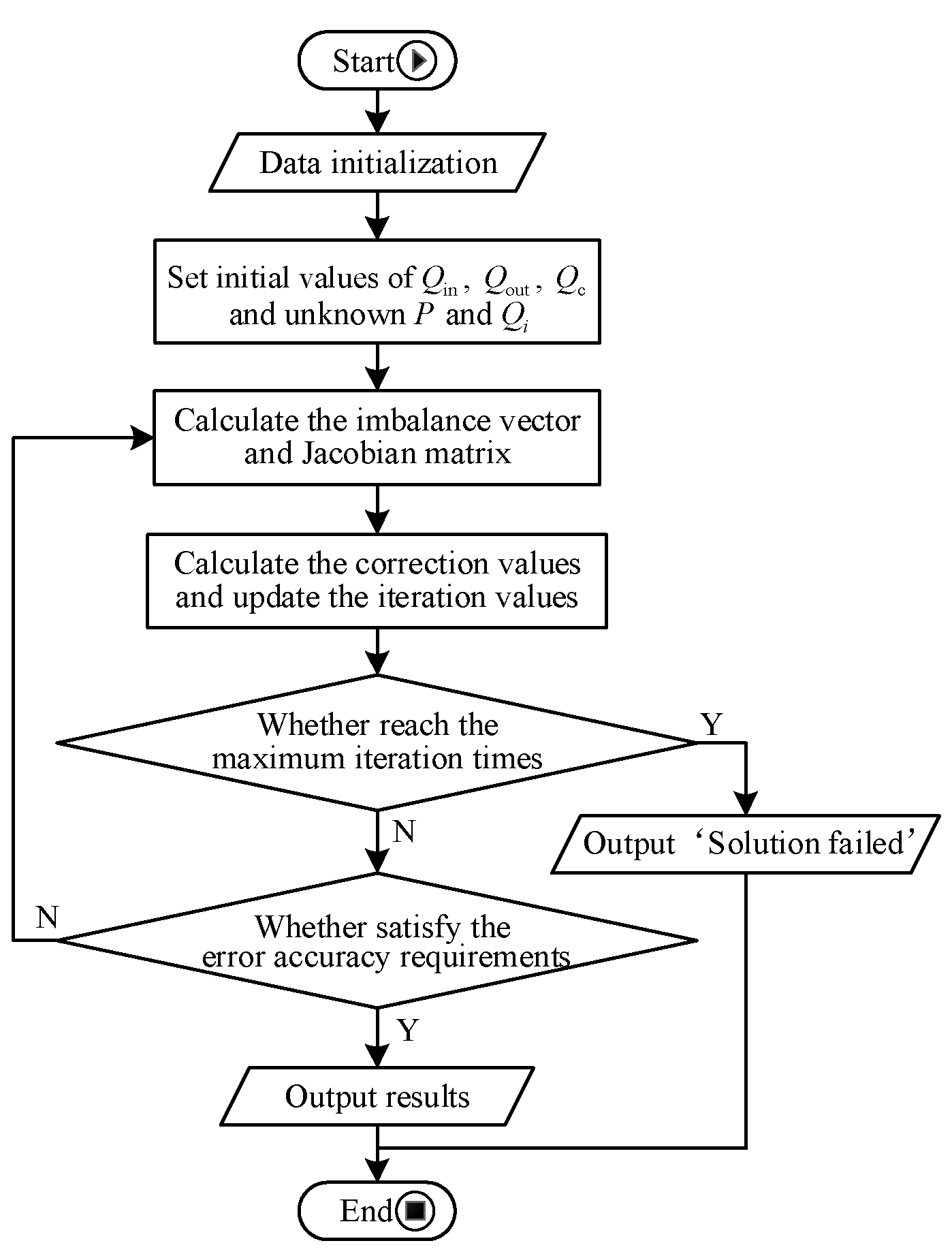



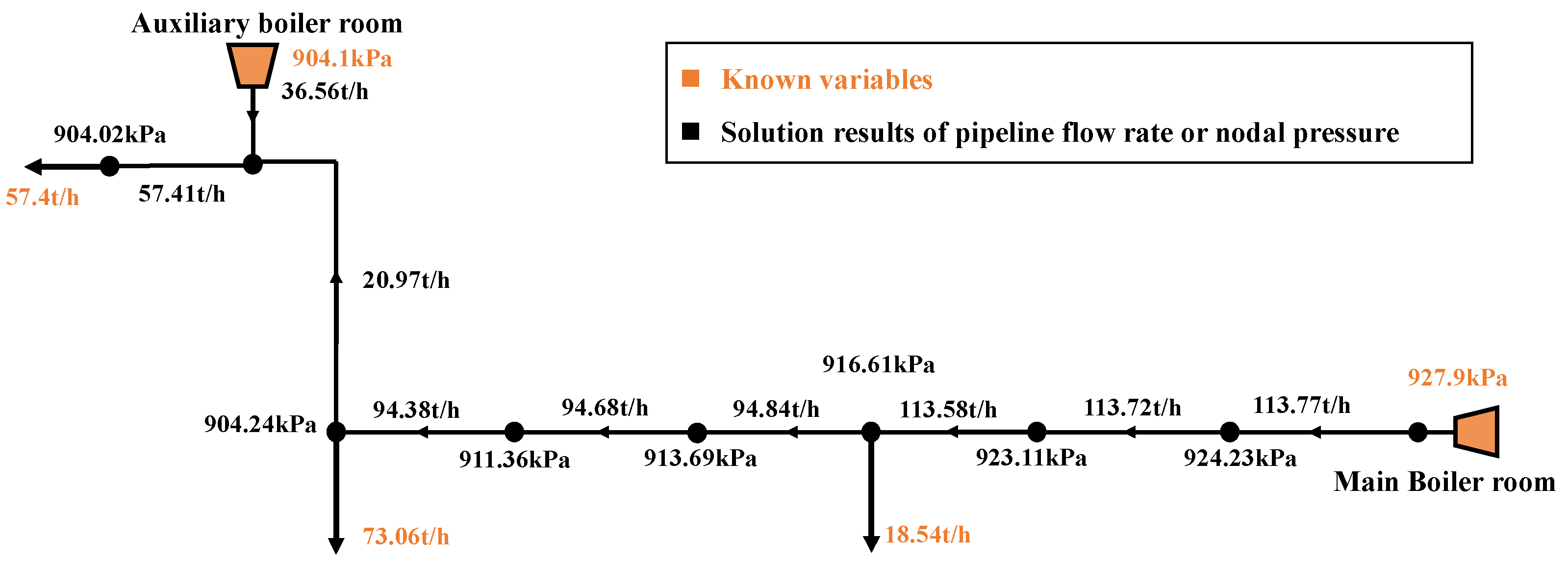
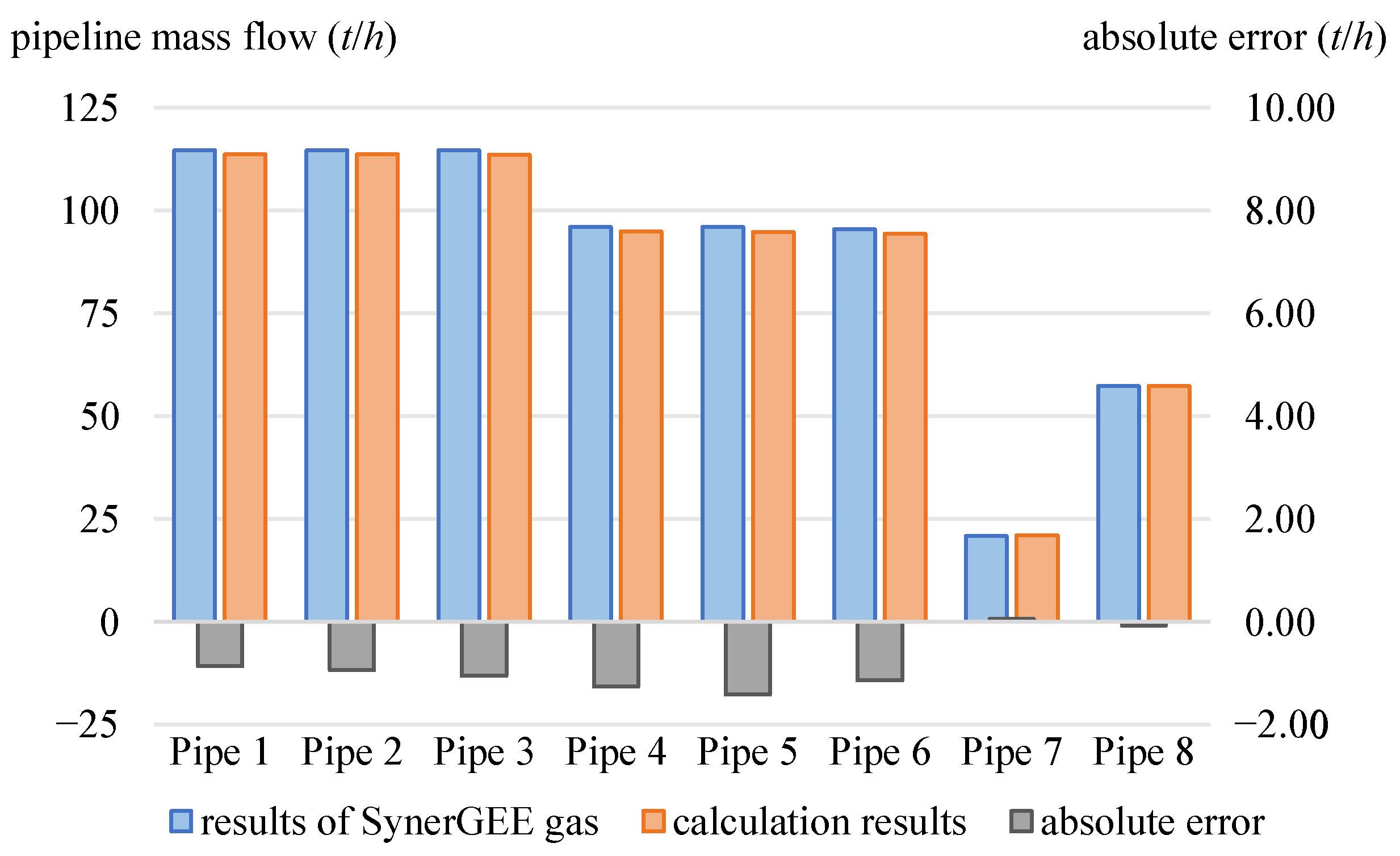
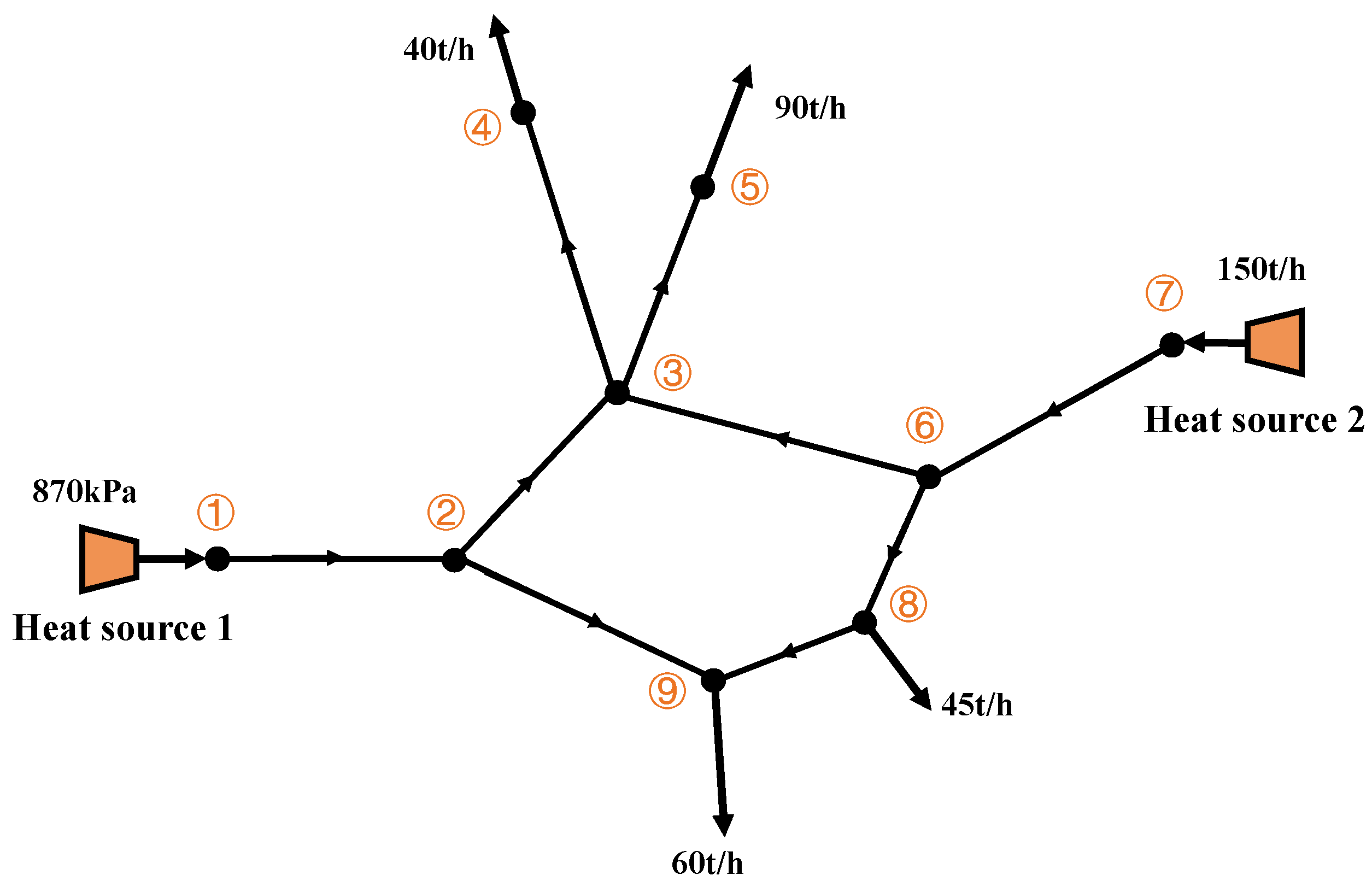
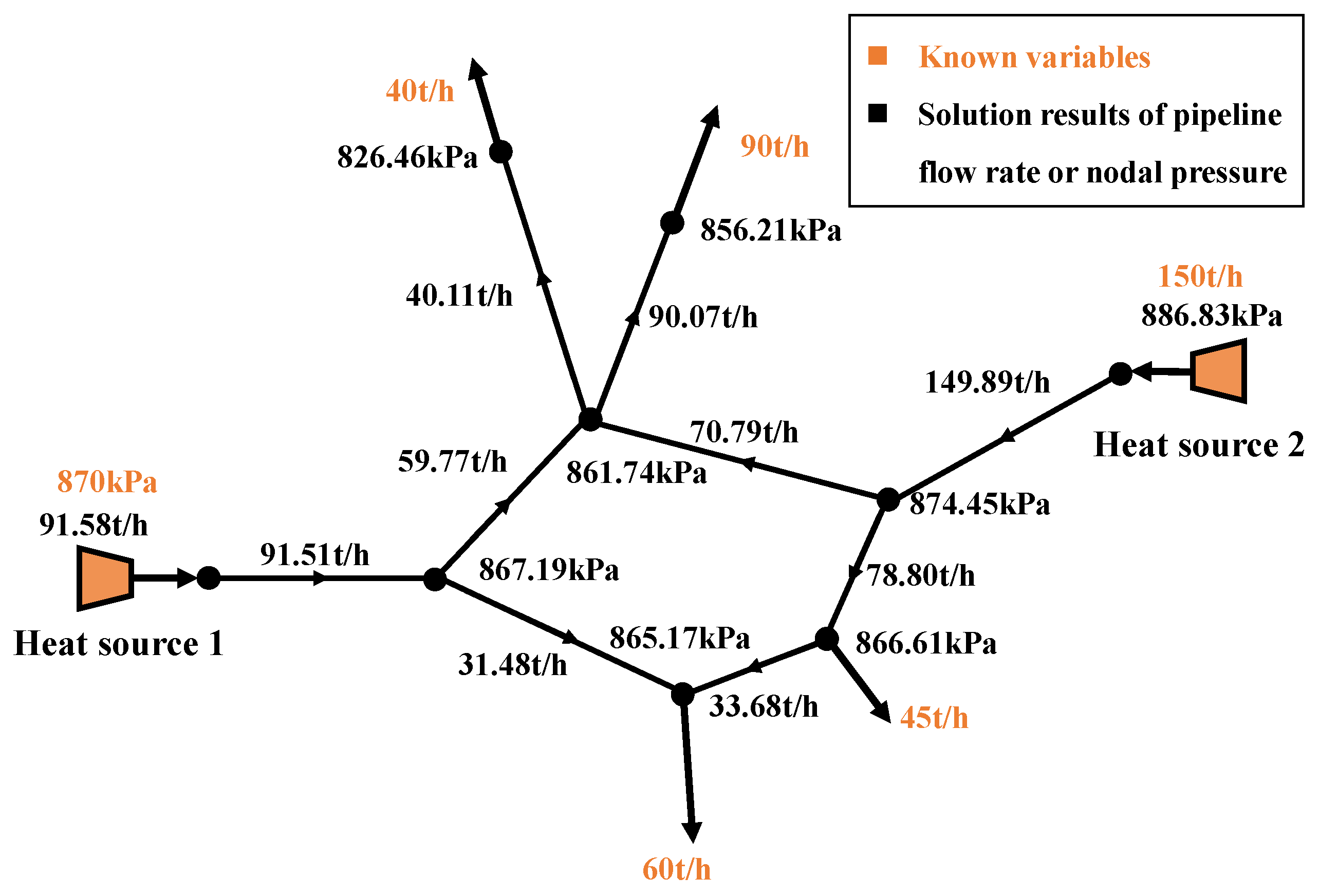


| Pressure Range (MPa) | c1 (×10−6 kg/(MPa·m3)) | c2 (kg/m3) |
|---|---|---|
| 0.10–0.32 | 5.2353 | 0.0816 |
| 0.32–0.70 | 5.0221 | 0.1517 |
| 0.70–1.00 | 4.9283 | 0.2173 |
| 1.00–2.00 | 4.9008 | 0.2465 |
| 2.00–2.60 | 4.9262 | 0.1992 |
| Control Equations | Quantity |
|---|---|
| Pipeline momentum conservation equations | M |
| Nodal mass flow conservation equations | M |
| Pipeline mass flow conservation equations | M |
| Pipeline energy conservation equations | N |
| Unknowns | Quantity |
|---|---|
| Qin | M |
| Qout | M |
| Qc | M |
| P or Qi | N |
| Results of SynerGEE Gas | Model in This Paper | Model in [11] | ||
|---|---|---|---|---|
| Pipeline Flow (t/h) | Relative Error | Pipeline Flow (t/h) | Relative Error | |
| 114.6 | 113.589 | 0.91% | 112.4 | 1.91% |
| 114.6 | 113.527 | 0.96% | 112.4 | 1.91% |
| 114.6 | 113.427 | 1.05% | 112.4 | 1.91% |
| 96.09 | 94.7126 | 1.43% | 93.90 | 2.28% |
| 96.09 | 94.5772 | 1.57% | 93.90 | 2.28% |
| 95.52 | 94.3206 | 1.26% | 93.90 | 1.70% |
| 20.91 | 20.9516 | 0.20% | 20.84 | 0.33% |
| 57.47 | 57.4043 | 0.11% | 57.40 | 0.12% |
| Maximum relative error | - | 1.57% | - | 2.28% |
| Iteration times | 4 | - | 10 | - |
| Solution time | 1.32 | - | 333,281.63 | - |
| 12:00 A.M. | 12:00 P.M. | |
|---|---|---|
| Power load | 259 MW | 129.5 MW |
| Steam heating load | 384 t/h | 318.7 t/h |
| Position of Working Electric Boiler(s) | Injected Active Power of the Slack Bus/MW | Peak-Valley Difference/MW | Percentage Change of Peak-Valley Difference | |
|---|---|---|---|---|
| Day | Night | |||
| None | 236.31 | 100.52 | 136.09 | - |
| Node 4 | 236.31 | 116.78 | 119.83 | −11.95% |
| Node 4 and Node 11 | 236.31 | 131.98 | 104.63 | −23.12% |
| Node 3, Node 4, and Node 11 | 236.31 | 142.98 | 93.63 | −31.20% |
Publisher’s Note: MDPI stays neutral with regard to jurisdictional claims in published maps and institutional affiliations. |
© 2022 by the authors. Licensee MDPI, Basel, Switzerland. This article is an open access article distributed under the terms and conditions of the Creative Commons Attribution (CC BY) license (https://creativecommons.org/licenses/by/4.0/).
Share and Cite
Chen, J.; Zhou, S.; Liu, Z.; Liu, H.; Zhan, X. A Novel Steady-State Simulation Approach for a Combined Electric and Steam System Considering Steam Condensate Loss. Processes 2022, 10, 1436. https://doi.org/10.3390/pr10081436
Chen J, Zhou S, Liu Z, Liu H, Zhan X. A Novel Steady-State Simulation Approach for a Combined Electric and Steam System Considering Steam Condensate Loss. Processes. 2022; 10(8):1436. https://doi.org/10.3390/pr10081436
Chicago/Turabian StyleChen, Jinyi, Suyang Zhou, Zhong Liu, Hengmen Liu, and Xin Zhan. 2022. "A Novel Steady-State Simulation Approach for a Combined Electric and Steam System Considering Steam Condensate Loss" Processes 10, no. 8: 1436. https://doi.org/10.3390/pr10081436
APA StyleChen, J., Zhou, S., Liu, Z., Liu, H., & Zhan, X. (2022). A Novel Steady-State Simulation Approach for a Combined Electric and Steam System Considering Steam Condensate Loss. Processes, 10(8), 1436. https://doi.org/10.3390/pr10081436






